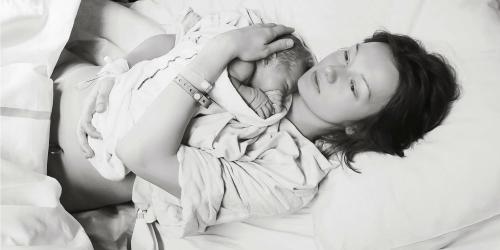New pavement in the fed up of obstetric violence. Thursday, July 20, 2017, Marlene Schiappa, Secretary of State for Equality between men and women, said that the episiotomy rate in France is 75% "while the WHO normally advocates to be around 20-25% ", during a hearing of the Women's Rights Delegation 1 .
"Your numbers are wrong" then quickly responded the National College of Gynecologists and Obstetricians French (CNGOF), through an open letter sent July 24. "Deeply shocked" by such remarks, the CNGOF adds that "the last official and public evaluation carried out in 2010 reported 27%, with a halving since the previous count which was 55% in 1998."
In a statement 2 issued in the wake, the Secretary of State explains that this figure is actually a study conducted in 2013 by the association of Marlene Schiappa, Maman Work, which showed that out of 983 mothers interviewed, 75% of between them had reported having an episiotomy.
Perceived (and felt) as "barbaric" by many women, who feel they do not always consent to this act, which is still practiced "systematically" in France, episiotomy is once again at the heart of the debate on obstetric violence.
But how did we come to such distrust?
Episiotomy, what is it?
This surgical procedure, performed by a midwife or obstetrician, consists of making a perineal incision to prevent a possible tearing of the anal sphincter, ie the complete perineum, during childbirth.
More precisely, the vaginal mucosa and superficial perineal muscles are cut in order to enlarge the opening of the vulva.
The episiotomy can be median (up to the anus) or lateral (on the side).
 Credit: BSIP / Getty Images
Credit: BSIP / Getty Images
In which cases is episiotomy performed?
Generally, it is recommended to facilitate the passage of the baby during childbirth when the work becomes too long, the size of the head of the unborn child is too important, the latter is presented by the seat or is in a respiratory emergency.
"The episiotomy has no formal indications and remains subjective," says Professor Philippe Deruelle, gynecologist-obstetrician at the University Hospital of Lille and Secretary General of the National College of Gynecologists and Obstetricians French.
"It is really necessary in certain situations of common sense of the midwife or the obstetrician," adds Professor Philippe Descamps, obstetrician-gynecologist and head of the Mother-and-Child-Center at CHU d'Angers 3 .
"For years, we encouraged future doctors to practice episiotomy as a beneficial gesture to protect women," says Professor Deruelle. "But there is a lot of scientific evidence that it was not," he says.
An act with consequences sometimes heavy consequences
"The episiotomy may trigger haemorrhage, injuries to the anus and rectum, infections, pain and cicatricial disunity," says Philippe Deruelle.
Side effects often very poorly experienced by women, as evidenced by some topics of discussion on the forums.

Credit: Forum aufeminin.com

Credit: Forum doctissimo.fr
In 2013, the designer Emma also illustrated in her blog post titled "The story of my girlfriend Cécile" how the episiotomy had upset one of her friends during and after her delivery. A physical and psychological shock for this young woman who had just expressed in writing her refusal to undergo the act in question.

 Credits: emmaclit.com
Credits: emmaclit.com
Efforts to be made on patient consent
In 2005, episiotomy was performed on 47% of women (68% for a first birth, 31% for the next).
At that time, the CNGOF published recommendations, saying that there was "no proven evidence for systematic episiotomy" and called for a lowering of this practice to an overall rate of 30%.
For its part, the Ciane (Collective Interassociative Around the Birth), diligente a study 4 on the subject between 2010 and 2013 to see the progress of practices.
As a result, the number of episiotomy is reduced to 30% (47% for a first delivery and 16% for the following). On the other hand, patient consent is still not required in 85% of cases.
A rate of 20% of episiotomies recommended by WHO
For its part, the World Health Organization calls for a maximum rate of 20% of episiotomies. A figure that is largely attainable when we know that certain institutions such as the University Hospital of Lille account for only 10% of episiotomies per year.
Better still, according to figures obtained by the newspaper "Le Parisien" 5 , the CHU of Nanterre acts as a good student with 2.5% of episiotomies while the Hospital Center of Besançon "close even the 1%".
In France, it is difficult to obtain precise figures on the number of episiotomies practiced in each establishment.
Information that would improve practices and allow rate alignment, as Ciane had already demanded in 2013: "It is very unfortunate that episiotomy rates are not published by maternity. The CIANE appeals to the public authorities so that they respect this minimal requirement of transparency. The figures published by the maternity hospitals are all below or even below the national average, and the institutions that publish them are those with low rates. "
It is clear that efforts are still to be made.
Sources:
1 videos.senat.fr/video.379101_59704ef4e76fa.audition-de-mme-marlene-schiappa-secretaire-d-etat-chargee-de-l-galite-entre-men-and-the-fem?timecode=2294000
2 www.egalite-femmes-hommes.gouv.fr/wp-content/uploads/2017/07/cp-violences-obstetricales-240717.pdf
3 Author of the book "Doctor, I still have a question!" at Larousse Editions
4 ciane.net/wordpress/wp-content/uploads/2013/11/Enquête-pisiotomie-Ciane-2013.pdf
5 www.leparisien.fr/laparisienne/societe/des-gynecologues-et-des-femmes-se-mobilises-contre-the-episiotomie-21-02-2017-6697542.php




